Division of Agricultural Engineering
Field machinery and plant production
Our laboratory ( Field machinery and plant production) mainly focuses on engineering research, education and development on food production in outdoor fields (paddy and upland). With “to measure” and “to fabricate” as the keywords, conventional agricultural machinery is equipped with instrumentation and intelligent control, or its function is redefined by investigating on the properties of crop or weeds to cut into new frontiers between engineering and agronomy. We cordially welcome those who are interested in fabricating a machine, growing crops or measuring the system. Here are examples of our projects.
- Field server for monitoring the micro-climate of the field and growth status of the crop.
- Yield mapping of paddy fields: Our laboratory first published yield maps of paddy fields in Japan. We now aim at downsizing, high accuracy, and multi-functioning of the yield sensor for more practical applications.
- Individual weight sensors for onion bulbs on a harvester: Using the discipline of momentum and the arrangement of plural load cells, each onion weight is measured before entering the container. Mapping of size distribution of the onion bulbs throughout the fields feedbacks to cultural practice of the crop for enhanced profitability.
- Mechanical weeding for paddy fields: Environmentally friendly options are required for recent agricultural practices to support conservation of natural habitats or to promote non/reduced agrochemical products for marketing, with which we provide solutions by mechanical weeding and we investigate on weeding mechanism of several tools.
- Variability studies in a paddy fields: Each paddy fields looks flat enough, but even a couple of centimeters difference in micro-elevation leads to different protein content of the grain. Currently, drying methods (natural drying in the fields or artificial drying in a dryer) are linked to the palatability of the rice.
- New frontier for walk-behind transplanters: Conversion into a riding type implements both easy access to small terrace fields and less labor-intensive operation there. Aoutonomous guidance in large-scale fields is also test-tried.
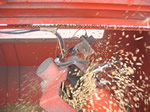
A sonsor to detect grain weight from the impact of the grain in the tank of a combine
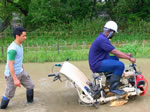
Converting a walk-behind transplater into a riding type
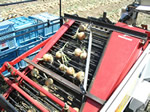
Sensors are installed on an onion picker to measure individual weights of the bulbs
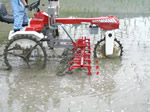
A mechanical weeder under development - a must for non-chemical practices
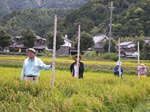
Surveying micro-elevation of the fields to relate to the efficacy of mechanical weeders
Field machinery and plant production Web Site




